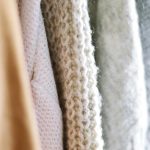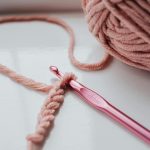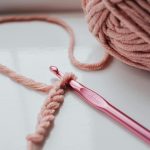When you consider using chenille for your home, it's essential to weigh its characteristics against your year-round needs. This fabric's softness and texture can enhance coziness, but its suitability might vary across seasons. You might find yourself wondering if it'll hold up during the heat of summer or keep you warm during winter months. As you think about its benefits and potential drawbacks, there are specific factors that could influence your decision. Let's explore those key aspects that could help clarify whether chenille is truly a versatile choice for all year.
Table of Contents
What Is Chenille?
Chenille is a soft, velvety fabric made from tightly twisted yarns that resemble caterpillars, giving it a unique texture and appearance. You might appreciate its luxurious feel, which adds a touch of elegance to any home décor. Often used in upholstery and throw blankets, chenille combines style with comfort.
You can find chenille in various colors and patterns, making it easy to incorporate into your interior design. Its inviting texture draws attention, and it can elevate even the simplest spaces. Think about how it can enhance your furniture or accent pieces, creating a cozy atmosphere.
This fabric is also notable for its durability. While it feels delicate, it can stand up to everyday use when properly cared for. Whether you're considering a new sofa or a decorative pillow, chenille provides options that balance aesthetics and practicality.
Many crafters enjoy using chenille for quilting and other textile projects, appreciating its softness and versatility. However, keep in mind that its unique construction requires certain care methods to maintain its appearance. When you choose chenille, you're opting for comfort with a bit of flair, perfect for transforming your living space.
Properties of Chenille
One of the standout characteristics of this fabric is its plush texture, which not only adds elegance but also makes it highly comfortable for a variety of applications. Chenille is woven from a blend of fibers, typically cotton or polyester, which gives it a soft yet durable quality. You'll notice the unique pile surface, created from tufted yarns, that enhances its tactile appeal.
Additionally, chenille has a natural adaptability to different environments. Its thickness can provide warmth during colder months, while the breathable fibers help it remain comfortable in warmer temperatures. The fabric's vibrant colors and rich patterns can also contribute to your home's aesthetic, adding depth to both modern and traditional decor.
Another property worth mentioning is its resistance to fading, making chenille an excellent choice for items exposed to sunlight. Plus, it tends to be easy to care for, as many chenille products are machine washable, allowing you to maintain their appearance over time. Be mindful, though, that its plushness can attract lint and pet hair, requiring a bit of regular upkeep. Ultimately, these properties make chenille a versatile choice suitable for various uses throughout the year.
Benefits of Chenille
When you choose chenille, you're embracing a fabric that offers remarkable softness and comfort, making it a pleasure to use year-round.
Plus, its durability ensures that it withstands the test of time without demanding much maintenance.
You'll find that these benefits make chenille an appealing option for your home.
Softness and Comfort
You'll instantly notice the luxurious softness of chenille, making it a perfect choice for cozying up in any season. This fabric is incredibly plush and feels gentle against your skin, providing a comforting experience that's hard to beat.
When you wrap yourself in a chenille throw or snuggle up on a chenille sofa, you'll appreciate how inviting and warm it can feel.
What sets chenille apart is its distinctive texture, characterized by its velvety loops. This unique construction not only enhances the tactile experience but also adds depth and richness to your decor.
Whether it's a chilly winter evening or a breezy summer night, chenille's softness adapts to your needs, providing the right amount of warmth without overheating you.
You can use chenille in various ways—blankets, cushions, or even clothing. In each case, you'll find that its plush feel invites you to relax and unwind.
Plus, the comfort it offers can make your home feel more inviting to your guests. Ultimately, if you're looking for softness and comfort in your textiles, chenille is an excellent choice that you won't regret.
Durability and Maintenance
Chenille's durable construction means it can withstand everyday use while still maintaining its plush appearance and feel. You'll appreciate how it holds up against wear and tear, whether it's in your living room or bedrooms.
The fabric's tightly woven fibers resist fraying and fading, making it an excellent choice for high-traffic areas or furniture that sees a lot of action.
When it comes to maintenance, chenille is surprisingly easy to care for. Most chenille fabrics can be spot cleaned with a mild detergent, which means you don't have to stress over spills or stains.
For deeper cleaning, many chenille items are machine washable, though always check the care labels to confirm. After washing, it usually retains its original softness and vibrancy.
This durability ensures that your chenille pieces won't just look good for a season; they'll stay beautiful year after year. Investing in quality chenille means you're choosing a fabric that combines elegance with resilience.
Drawbacks of Chenille
Chenille offers a soft touch.
It comes with some drawbacks, though.
It requires higher maintenance than other fabrics.
It won't stand the test of time as well.
It tends to accumulate dust, making regular cleaning more of a hassle.
Softer Texture, Higher Maintenance
Many find the softer texture of chenille appealing, but its higher maintenance can be a drawback for everyday use. Unlike sturdier fabrics, chenille requires more attention to keep it looking fresh and clean.
You might frequently need to vacuum or lint-roll chenille items due to its tendency to attract pet hair and dust.
Additionally, you'll want to be cautious about spills. While it's soft and inviting, that plush texture can absorb liquids quickly, leading to stains that may be hard to remove. If you have kids or pets, consider whether you're ready for the work that comes with managing messes.
Washing chenille can also be tricky; it often requires gentle cycles or hand washing, which can be time-consuming. You'll need to avoid bleach and harsh detergents to preserve its rich colors and softness.
When drying, it's typically best to air dry to prevent damage, adding yet another layer of maintenance.
In short, if you love that cozy feeling chenille offers, just be prepared for the upkeep that comes along. If you're up for the challenge, it can be a delightful addition to your home.
Limited Durability Over Time
You might love chenille for its soft feel, but you'll want to consider that its durability can fall short compared to other fabric options. Chenille fabrics tend to wear out quicker, especially in high-traffic areas or with frequent use. If you're using chenille for upholstery or throw blankets, you may notice signs of wear much sooner than expected.
Here's a quick comparison of chenille's durability against a few other popular fabric choices:
| Fabric Type | Durability Rating | Best Use Areas | Maintenance Level |
|---|---|---|---|
| Chenille | Moderate | Throw pillows, light use furniture | High |
| Cotton | High | Everyday items, bedding | Low |
| Linen | Moderate-High | Summer wear, drapery | Moderate |
| Leather | Very High | Furniture, accessories | Low-Medium |
While chenille can bring comfort and style, keep in mind that you'll likely need to replace it sooner than sturdier fabrics. If longevity is a priority for you, exploring other options might be the way to go.
Prone to Accumulating Dust
Chenille's textured surface makes it particularly prone to accumulating dust and allergens, potentially requiring more frequent cleaning than other fabrics. If you have allergies or respiratory sensitivities, this could be a significant drawback. The fibers tend to trap dust particles, pet dander, and even pollen, which can circulate in your home environment.
You'll find that maintaining a clean chenille fabric often demands regular vacuuming and periodic deep cleaning. Neglecting this upkeep might result in not just a dusty appearance but also an unhealthy living space over time. When particles settle into the fibers, they can become embedded, making them harder to remove and leading to stubborn stains.
Furthermore, the care instructions for chenille can be a hassle. While some pieces are machine-washable, others require delicate hand washing or professional cleaning—an added consideration if you're not prepared for routine maintenance.
Ultimately, while the rich texture and cozy feel of chenille are appealing, you should weigh the potential increase in cleaning effort against your lifestyle and comfort needs. Don't forget—your comfort comes at a cost!
Seasonal Suitability
Some may wonder if chenille fabric can comfortably fit into all four seasons. The answer is yes, but it depends on how you use it.
In winter, its soft, plush texture provides warmth and coziness. Snuggling up in a chenille throw while sipping hot cocoa is a perfect way to enjoy chilly evenings.
As for spring and autumn, chenille is light enough to remain comfortable during those transitional months. You can easily layer it with lighter fabrics when the weather warms up or use it as an extra layer on cooler nights.
Summer, however, is where you might face some limitations. Chenille can be a bit heavier and less breathable than other fabrics. On hot days, you might prefer lighter materials like cotton or linen. But you can still use chenille in summer evenings when temperatures drop.
Care Instructions
Caring for chenille fabric is important to maintain its softness and prevent damage, especially if you're using it throughout the year. Start by checking the care label for specific instructions.
Most chenille can be machine washed on a gentle cycle in cold water. Use a mild detergent to avoid harsh chemicals that could harm the fabric.
Avoid using bleach, as it can cause discoloration and weaken the fibers. After washing, you'll want to air dry your chenille pieces. If you must use a dryer, select a low heat setting and remove items promptly to prevent wrinkling.
For spot cleaning, use a soft cloth or sponge with a mild soap solution. Gently dab at stains instead of rubbing, as friction might damage the fabric.
When it comes to storage, keep your chenille items in a cool, dry place, ideally folded rather than hanging, to maintain their shape.
If you notice pilling over time, use a fabric shaver to remove those little snags without harming the overall texture.
Follow these care instructions, and your chenille will remain cozy and vibrant all year round.
Alternatives to Chenille
If you're looking for alternatives to chenille, consider fabrics like velvet, fleece, or microfiber, each offering unique textures and benefits for year-round use.
Velvet provides an ultra-luxurious feel with a rich sheen that can elevate any space. It's warm and cozy, perfect for chilly evenings, yet it can remain stylish through warmer months if paired correctly.
Fleece, on the other hand, is known for its incredible softness and insulating properties. It's lightweight and breathable, making it a fantastic choice for layering. You'll find fleece blankets ideal for snuggling up in winter while still being breathable enough for springtime use.
Microfiber is another excellent option, boasting a soft texture and durable quality. It's stain-resistant and easy to clean, which makes it great for households with kids or pets. Plus, you'll appreciate how versatile microfiber can be, adapting to both casual and formal settings.
Each of these alternatives can provide you with comfort and style similar to chenille, allowing you to choose what best suits your needs and preferences. Ultimately, the best fabric for you balances warmth, texture, and maintenance.
Frequently Asked Questions
Can Chenille Be Used for Outdoor Furniture?
You shouldn't use chenille for outdoor furniture. It absorbs moisture, making it prone to mildew and fading from sun exposure. Instead, opt for durable, weather-resistant fabrics designed specifically for outdoor use to ensure longevity.
How Does Chenille Compare to Cotton and Polyester?
Chenille's softness and texture often outshine cotton and polyester, but it lacks their durability. If you're after comfort, choose chenille; if you need longevity, cotton or polyester might be better options for your needs.
Is Chenille Hypoallergenic for Sensitive Skin?
Chenille isn't inherently hypoallergenic, but its soft fibers can be gentler on sensitive skin compared to rougher materials. If you're prone to allergies, consider washing it regularly to minimize potential irritants.
What Are the Best Color Options for Chenille Fabrics?
When choosing chenille fabrics, consider rich jewel tones like emerald or sapphire for elegance, or soft pastels for a calming effect. Bright colors add vibrancy, while neutrals offer versatility, making your space feel inviting.
Are There Any Specific Brands Known for Quality Chenille?
When searching for quality chenille, consider brands like Cuddl Duds, Premier, and Fabricut. They're known for their durability and comfort. You'll love how their fabrics elevate your home décor and personal style.
- How Does Ring Spun Cotton Affect Garment Fit and Shape Retention? - August 13, 2024
- What Are the Challenges in Producing Ring Spun Cotton? - August 13, 2024
- Is Ring Spun Cotton Suitable for Plus-Size Clothing? - August 13, 2024






